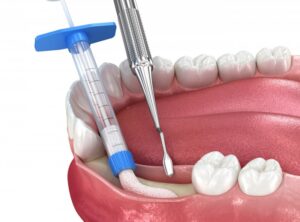
Millions of patients have benefited from getting dental implants, but not every one of those patients has been a good candidate for the procedure from jump. In fact, it’s not uncommon for patients who have experienced tooth loss years before investing in dental implants to require preparatory treatments, whether that’s a sinus lift or bone graft. Although these may seem like inconveniences that draw out your treatment timeline, they’re critical to the lifespan and long-term health of your dental implants and smile. Read on to learn more about bone grafting and when it’s necessary in order to restore your smile.
When is Bone Grafting Necessary to Get Dental Implants?
If you’re interested in restoring your smile with dental implants, the first step you will take to find out if this method of replacing missing teeth is right for you is to schedule a consultation with your dentist. This is where many patients hear that they need a bone graft.
When a patient doesn’t have enough jawbone density to capably support the dental implant posts, which are surgically secured within the jawbone and need to fuse with the bone for a successful procedure, a bone graft is needed. This is often the case for patients who have developmental conditions that have caused their jawbone to be thinner, oral health conditions like gum disease, past facial injuries or trauma, or have suffered from tooth loss in the past.
How Do You Know if You Need a Bone Graft?
During your initial dental implant consultation, your dentist will capture a cone beam CT scan of your entire facial structure. This will allow them to see a 3D model of your facial anatomy, including the location of nerves, sinuses, and even jawbone density. Based on their review of your diagnostic image, your dental implant dentist in Lancaster will be able to inform you of whether your jawbone is dense enough to support the successful fusion of dental implants. If not, they may recommend a bone graft prior to scheduling your dental implant placement.
What Type of Bone Graft Will You Need?
Depending on your unique circumstances, you may require either a socket graft, lateral ridge preservation graft, or a block bone graft. Socket grafts are more preventive in nature, as they’re recommended to help prevent the erosion of the alveolar bone (which surrounds your tooth roots) after a tooth is removed. Lateral ridge preservation grafts are designed to increase the width of the jawbone to help support the dental implant, and block bone grafts are typically used when there are defects in the jawbone. Each of these different types of bone grafts requires up to six months of healing time.
If you hear that you need a bone graft before your dental implants can be placed, don’t panic. Your dental implant dentist will thoroughly outline why the procedure is needed as well as walk you through what you can expect, making sure you understand what you agree to. Although a bone graft may seem like an inconvenience that will set back your treatment timeline, it’s well worthwhile, as it can drastically increase your chances of enjoying a natural looking and feeling smile for a lifetime.
About the Author
Dr. Jason Herres is our in-house dental implant expert at Dentistry for Life, bringing countless years of experience to help put his patients’ nervousness at-ease. He completed a three-year independent study in periodontics and implant placement with four of the Navy’s top periodontists. This advanced training allows him to complete dental implant placement and restoration in-house, as well as other advanced procedures, like bone grafts. For questions or to schedule a dental implant consultation, visit Dentistry for Life’s website or call 717-569-3911.
